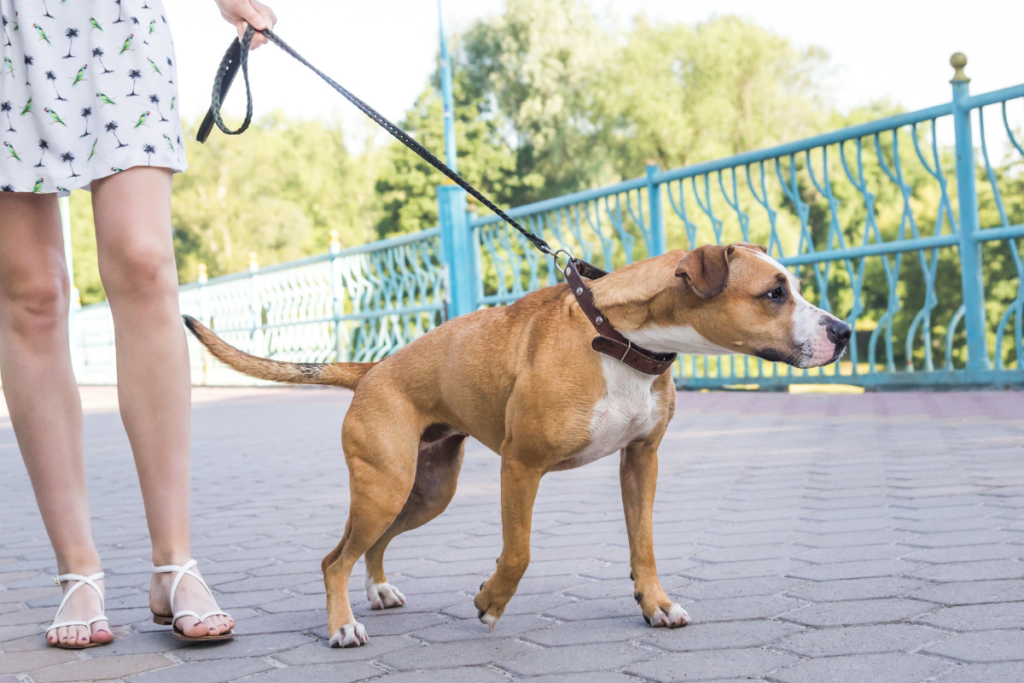This is one of the questions we get asked as trainers a lot. If we had a magic wand we would use it, but unfortunately dog trainers do not. So it is up to us to help you understand why your dog may be pulling, then work on teaching an alternate behaviour that is just as rewarding for your dog! Sounds easy right? Read on to find out how.

Reasons why dogs pull
Your dog may be excited, over aroused, overwhelmed or even fearful, and let’s face it,
dogs move faster than us humans. If your dog has learnt from past experiences that
pulling gets them to where they want to go – to another dog for example, or to that
interesting tree or shrub, then they will continue to do it. Behaviours that are rewarded
are more likely to be repeated. So, let’s start with some of those behaviours we do want
repeated.
Training
The key is to practice in an easy environment first, so for example your house or back yard. Grab some high value treats, your dog and their walking equipment and let’s begin! First, let your dog sniff and get used to the environment/area.
Getting Your Dog’s Focus
Build the focus with you and your dog by playing a game we call “The Up and Down Game”. It is part of pattern games developed by dog trainer Leslie McDevitt. Simply place a treat on the ground and let your dog eat it, then when your dog looks back up at you, mark or click (a clicker is good for this), and then place another treat on the ground. Repeat, repeat, repeat!
You can start to add a little movement into this game when your dog gets the hang of it. Take a step or 2 away from your dog when they are eating the treat, when they move towards you, mark or click and then treat.
Walking Treat Dispenser
You are the treat dispenser! All the good stuff comes from you and at a rate that keeps your dog’s interest. Take one step, feed, take 2 steps, feed, and feed in your ‘reinforcement zone’ – this is the area you want your dog to be! We often describe it as having 2 invisible hoops on each side of your legs. This is where you want to feed your dog, so that they are more likely to repeat the behaviour of walking next to you.
Sniff and Go Game
Find points of interest that are a short few steps away (a tree/shrub, light pole etc). Practice taking a few steps towards the point of interest, mark and treat each step, then mark once you are next to the object and cue your dog to ‘go sniff’, so they can have a break. Sniffing is the reward! The sniff and go game is great for dogs that get over excited and like to pull towards something. If they can walk nicely for a few paces, then their reward is to sniff that tree!
Equipment
Your dog’s walking equipment (harness/collar) needs to be comfortable, safe, fitted well and preferably non-restrictive. Harnesses that restrict movement or ‘anti-pull’ harnesses can do long term damage to muscles and ligaments so be careful what you choose. You also don’t want to see pain, fear or intimidation to train your dog. Collars such as check chains and prong collars are unnecessary and can be very dangerous. Think of your dog’s equipment as a safety component (and council requirement!) of your walking.
Tips
- The walk is for your dog, not for you.
- The leash should be loose and ‘smiley’. If your dog pulls, stop and gently meet the pressure, then ask your dog to come back to where the leash is loose.
- Allow sniffing on walks. Not allowing sniffing is like going for a ride in the car and not being allowed to look out the window!
- Avoid pulling the lead or jerking it. This just makes it uncomfortable for your dog, hard on you and sends mixed messages.
- If you can’t get focus from your dog at the front gate, turn around and practice in the backyard until the focus becomes easier for your dog.
- Practice makes perfect!
Now you’re walking! If you need further help with walking your dog, please contact qualified force free dog trainer.
Happy Training!
